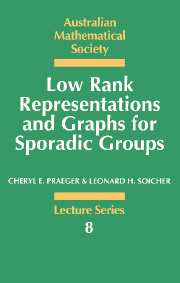1 - Low Rank Permutation Groups
Published online by Cambridge University Press: 15 September 2009
Summary
Introduction
Many interesting finite geometries, graphs and designs admit automorphism groups of low rank. In fact, it was a study of the rank 3 case which led to the discoveries and constructions of some of the sporadic simple groups (see [Gor82]). For several classification problems about graphs or designs, the case where the automorphism group is almost simple is of central importance, and many of the examples have a transitive automorphism group of low rank. This is the case, for example, for the classification problems of finite distance-transitive graphs [BCN89, PSY87], and of finite flag-transitive designs [BDD88, BDDKLS90].
This book presents a complete classification, up to conjugacy of the point stabilizers, of the faithful transitive permutation representations of rank at most 5 of the sporadic simple groups and their automorphism groups. These results, summarized in Chapter 5, filled a major gap in the existing classification results for finite, low rank, transitive permutation groups. For each representation classified, we also give the collapsed adjacency matrices (defined in Section 2.3) for all the associated orbital digraphs. We use these collapsed adjacency matrices to classify the vertex-transitive, distance-regular graphs for these low rank representations, and discover some new distance-regular graphs of diameter 2 (but of rank greater than 3) for the O'Nan group O'N, the Conway group Co2, and the Fischer group Fi22.
- Type
- Chapter
- Information
- Publisher: Cambridge University PressPrint publication year: 1996



